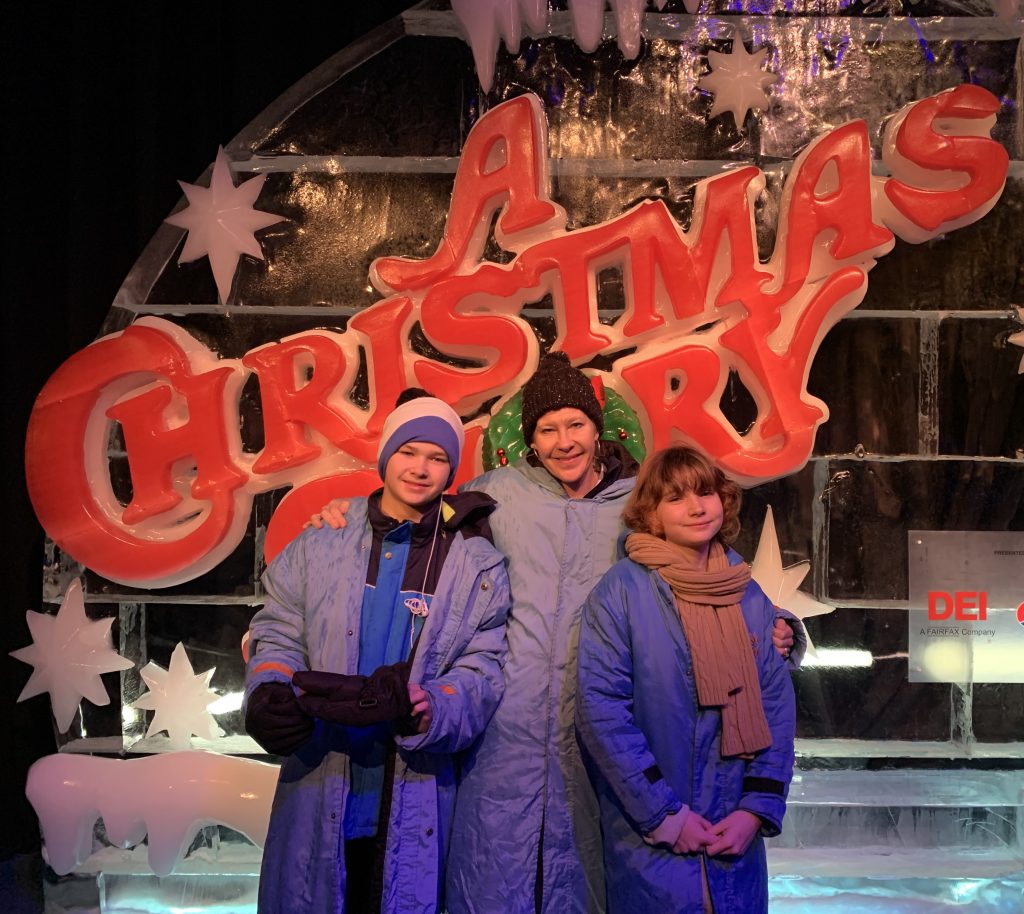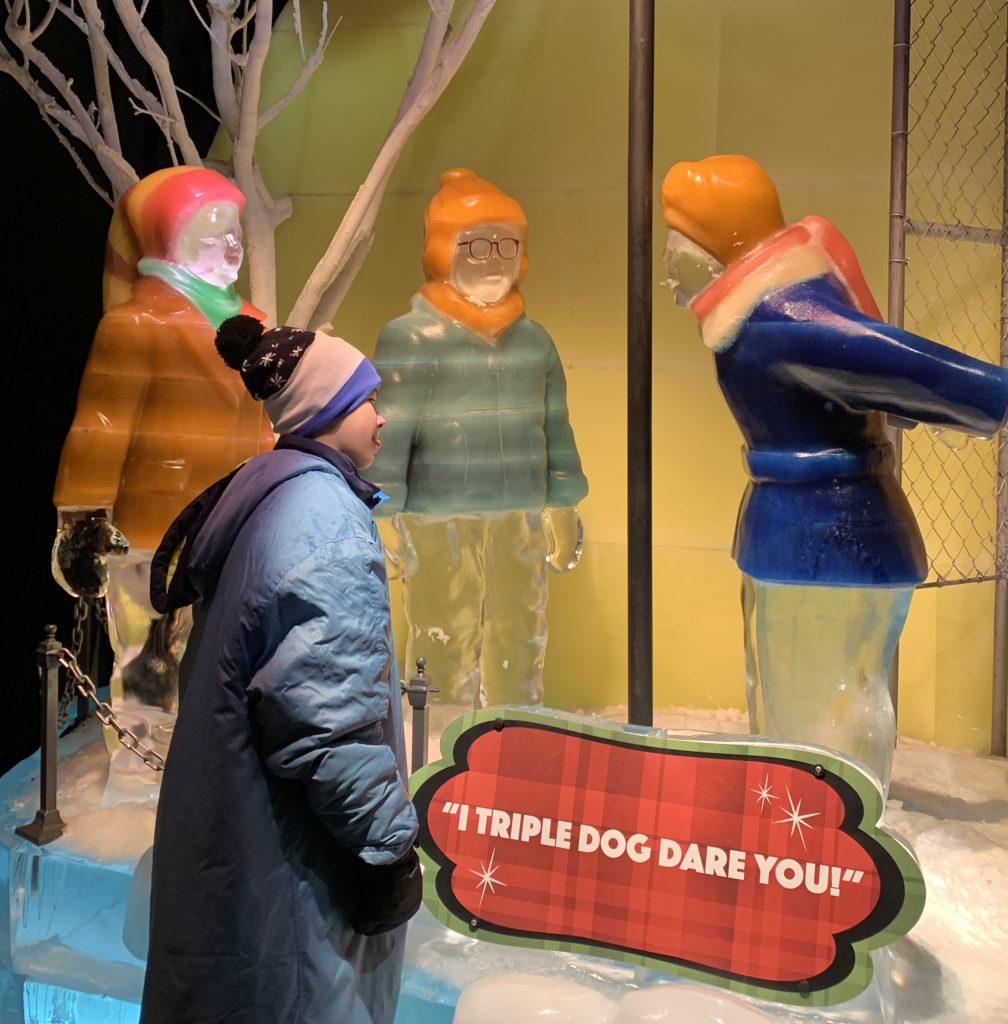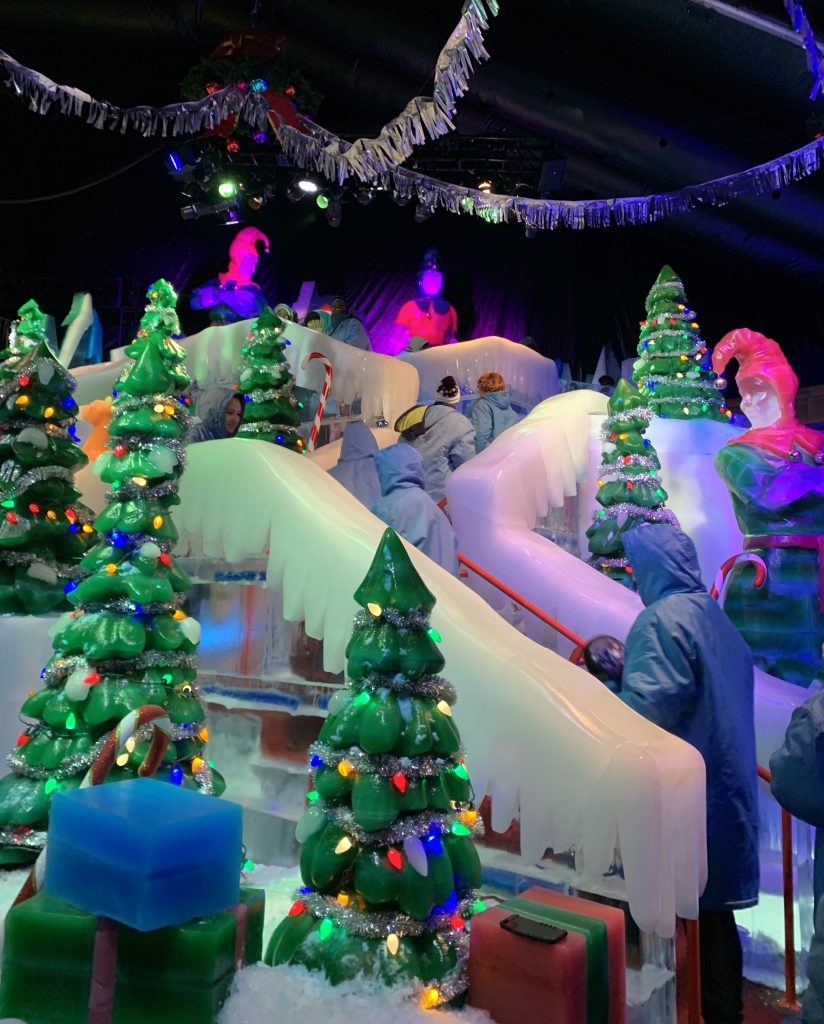
Our neurodiverse family recently visited the holiday display literally named ICE, which occurs each year at the Gaylord Hotel at National Harbor in the Washington DC area and other Gaylord Hotels around the US.
ICE is an impressive display of larger-than-life ice sculptures carved from two million pounds of colorful ice. The theme for ICE changes each year. In 2022, each sculpture at the National Harbor show depicted a scene from the classic holiday movie, “A Christmas Story,” and one of the final sculptures was a giant carved scene depicting the department store Santa Claus who admonished Ralphie when he asked for a B.B. gun for Christmas (you’ll shoot your eye out!) then booted him to send him sailing down a slide. Santa, toy soldiers, wrapped gifts, Christmas trees and usable stairs leading up to, and four lanes of slides leading off, the sculpture were all included in the astounding ice scene.

Leading up to the outing, we took various steps to increase the likelihood of success: we confirmed with the kids that they wanted to go to the event, talked them through and showed pictures of what was included in the display, bought tickets beforehand (a must), ensured everyone had clothing (hats, gloves, sneakers / boots; parkas are provided at event check-in) to keep them warm in the 9-degree environment, and had food before we went inside. The one factor I hadn’t been able to effectively control was a lack of sleep the night before.
On the day of our timed tickets, Jeffrey announced he had had a baaaaad night’s sleep. He said his brother – who sleeps in another room – woke him up at 1 am talking in his sleep, then woke him up again and again by snoring, plus his alarm clock light was too bright, so he never really got back to sleep. Not an ideal setup for an outing where fun is on the agenda.
The day was kind of a struggle for him – lots of tv time and picking on his brother and sister, and by the time we were scheduled to head to ICE, Jeffrey was trying to back out, to which I replied, “No can do – we’ve already bought the tickets.” He was not happy but he climbed into the car.
Once inside ICE, he made it clear he didn’t want any photos taken of him. He eventually softened on that and seemed to enjoy the display well enough but couldn’t keep his hands off his brother.
Then, on the fourth and final slide run, Jeffrey waited at the side of the slide, and as Jack came whizzing down with a smile on his face, Jeffrey took off his gloves, pulled them back, and hit Jack right in the face with them. The shock of being pummeled knocked Jack backward. He somehow laughed it off – which led parents standing around the slide to laugh at such an excellent practical joke (mostly because it wasn’t their kids on the giving or receiving end), but behind the smile, Jack was understandably unhappy. So was I.
This brings me to my main point – sleep and neurodiversity.
Sleep problems are twice as common for autistic kids and also very common among children with ADHD who often have a very difficult time falling asleep possibly because people with ADHD can have an inaccurate circadian clock. Autism and ADHD also result in higher-than-normal rates of sleep apnea. Then there are the medications taken by many neurodiverse kids, which can also impact sleep.

Sleep issues unique to autism can include difficulty “reading and expressing their own body’s cues – like hunger, which can make falling asleep more difficult”, as well as “hypersensitivity to light, sound, and touch.” Autistic individuals also spend less sleeping time than neurotypical people in “the rapid eye movement (REM) stage, which is critical for learning and retaining memories.”
The typical solutions to sleep issues don’t always work for neurodiverse people –melatonin secretion may be irregular and not produced at the right times of day in people with autism.
Because the same parts of the brain regulate both sleep and certain kinds of neurodiversity, a lack of sleep can heighten symptoms of both autism and ADHD – challenges with decision-making, getting stuck, inflexibility, difficulty focusing, forgetfulness, and meltdowns.
So how can we help our neurodiverse kids get a better night’s sleep on a regular basis? Here are three tips commonly suggested by experts:

Make the bedtime routine consistent as often as possible – from dinner through wind down, clean up, and lights out, try to stick to the plan.
Encourage reading before bed – nothing scary, but beyond that, let them read their material of choice.
Problem solve – remove anything overstimulating, distressing, or distracting – lights, clutter, and even bright room tones can be problematic. Consider blackout curtains and fully dimming clocks, and be mindful of typical household noises (e.g., the air conditioner kicking on or a faucet dripping) that can irritate a neurodiverse kid.
What sleep-improving habits work for your neurotypical family? We’d love to hear them!

